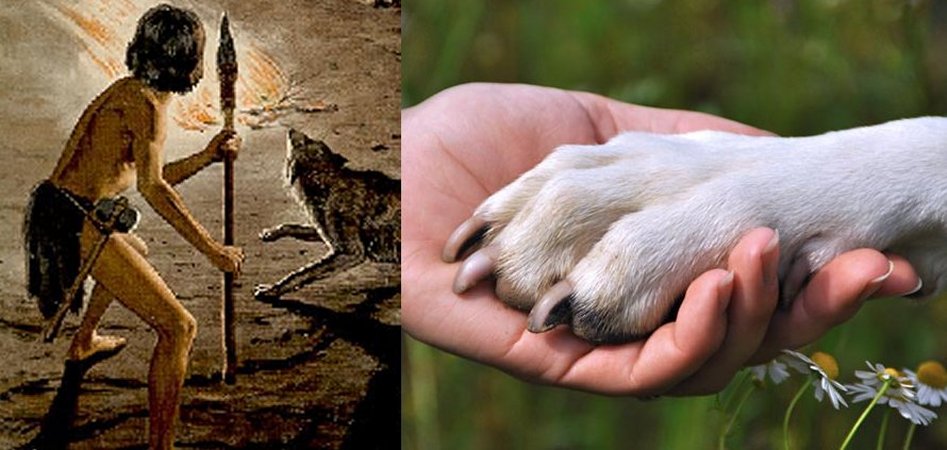26,000-Year-Old Footprints In Chauvet Cave: Oldest Evidence Of Human-Canine Relationship
Ellen Lloyd - AncientPages.com - Humans and dogs have shared a special relationship for thousands of years. Dogs are our companions, trusted friends, and family members. They bring joy into our lives, which has been the case for ages.
The Chauvet Cave in France contains plenty of remarkable paintings between 20,000 and 30,000 thousand years old and of great historical importance. Many scholars believe that the images found in the Chauvet Cave mark the emergence of a recognizable consciousness.
Interestingly, none of the hundreds of glorious Chauvet paintings show wolves. However, this intriguing ancient cave preserves something exciting: the footprints of a human child about four-and-a-half feet tall and many prints of large canids and bears.
Many consider these footprints the world's oldest evidence of the human-canine relationship.
First spotted in 1994 by Jean-Marie Chauvet, the cave's discoverer, the footsteps stretch perhaps 150 feet and sometimes cross those of bears and wolves.
The steps lead to the so-called room of skulls, where several bear skulls have been found. In a few places, there is evidence that the boy slipped on the soft clay floor, though Garcia says the prints show the boy was not running but walking normally.
Caveboy left footprints in the clay of time.
The boy appears at one point to have stopped to clean his torch. The charcoal has been dated to about. 26,000 years ago.
The discovered canid prints have a shortened middle digit on the front paw: a characteristic of dogs. Garcia suggested that the child and a large dog might have explored the cave together.
The prints from the Chauvet Cave, like nearly all footprints thus far discovered in Palaeolithic caves, are from bare feet. This has led scholars to speculate that people of the time either left footwear at cave entrances or carried them.
Prehistoric art expert Paul Bahn notes that depictions of carnivores, including wolves or dogs and humans, are rare. Bahn conjectures that portraying wolves and humans might have been taboo.
Gallery of the Chauvet cave may depict a volcanic eruption. Left: general view; right: traced detail, with an overlaid charcoal painting of a giant deer species removed (lower right). D. Genty (left)/V. Feruglio/D. Baffier (right)/CC BY 4.0
Anne Pike-Tay of Vassar College offers another perspective. She observes that the scarcity of artistic depictions of carnivores parallels their absence in the fossil faunas of the Upper Paleolithic. If domesticated dogs were helping humans hunt, she speculates that they might have been placed in a completely different symbolic category from other animals.
"What if dogs were put in the 'human family' category as an extension of the hunter and, like humans, warranted no (or very few) painted or engraved depictions?" she wonders.
Updated on September 10, 2024
Written by Ellen Lloyd – AncientPages.com
Copyright © AncientPages.com All rights reserved. This material may not be published, broadcast, rewritten or redistributed in whole or part without the express written permission of AncientPages.com
Expand for referencesMore From Ancient Pages
-
 Sogdian Temple Of Jartepa II On Caravan Road Of The Silk Road
News | Sep 3, 2020
Sogdian Temple Of Jartepa II On Caravan Road Of The Silk Road
News | Sep 3, 2020 -
 Mystery Of The Lost Golden Chain Of Huayna Capac: Will The Ancient Inca Treasure Ever Be Found?
Artifacts | Dec 30, 2020
Mystery Of The Lost Golden Chain Of Huayna Capac: Will The Ancient Inca Treasure Ever Be Found?
Artifacts | Dec 30, 2020 -
 Medieval Friars Were ‘Riddled With Parasites,’ Study Finds
Archaeology | Aug 19, 2022
Medieval Friars Were ‘Riddled With Parasites,’ Study Finds
Archaeology | Aug 19, 2022 -
 Skeleton Of Irish Giant Charles Byrne Will Not Be Displayed In The Hunterian Museum In London
Historical Figures | Jan 13, 2023
Skeleton Of Irish Giant Charles Byrne Will Not Be Displayed In The Hunterian Museum In London
Historical Figures | Jan 13, 2023 -
 We Need To Look Underwater To Understand Our Past – New Study
Archaeology | Apr 14, 2023
We Need To Look Underwater To Understand Our Past – New Study
Archaeology | Apr 14, 2023 -
 Strange Cave Drawings Of Unknown Beings And Animals In Japan Puzzle Historians
Ancient Mysteries | Dec 2, 2019
Strange Cave Drawings Of Unknown Beings And Animals In Japan Puzzle Historians
Ancient Mysteries | Dec 2, 2019 -
 Kingdoms Of Judah And Babylon Remained In Long-Lasting Conflict
Featured Stories | Sep 5, 2019
Kingdoms Of Judah And Babylon Remained In Long-Lasting Conflict
Featured Stories | Sep 5, 2019 -
 Extraordinary Ancient Mosaics, Crucifixes, And Long-Lost Church Discovered In The Holy Land
Archaeology | Dec 22, 2017
Extraordinary Ancient Mosaics, Crucifixes, And Long-Lost Church Discovered In The Holy Land
Archaeology | Dec 22, 2017 -
 Fake Or Genuine? 2,000-Year-Old Gold Torc Found In Trollhättan, Sweden Must Be Examined
Archaeology | Mar 21, 2025
Fake Or Genuine? 2,000-Year-Old Gold Torc Found In Trollhättan, Sweden Must Be Examined
Archaeology | Mar 21, 2025 -
 Mysterious Megaliths Of Russia May Offer Evidence Of An Ancient Advanced Lost Civilization
Ancient Technology | Jul 22, 2017
Mysterious Megaliths Of Russia May Offer Evidence Of An Ancient Advanced Lost Civilization
Ancient Technology | Jul 22, 2017 -
 Quatrefoil Symbol Was Used By The Olmecs And Maya Long Before It Appeared On Christians Churches
Ancient Symbols | Mar 19, 2018
Quatrefoil Symbol Was Used By The Olmecs And Maya Long Before It Appeared On Christians Churches
Ancient Symbols | Mar 19, 2018 -
 New Method Reveals Falsified And Original Manuscripts Of Famous Robert Burns
Archaeology | Jul 28, 2018
New Method Reveals Falsified And Original Manuscripts Of Famous Robert Burns
Archaeology | Jul 28, 2018 -
 The Prophecy Of The Rainbow Warriors And Future Of Planet Earth
Featured Stories | Aug 29, 2018
The Prophecy Of The Rainbow Warriors And Future Of Planet Earth
Featured Stories | Aug 29, 2018 -
 Stonehenge’s Monumental Altar Stone Came From Scotland – Not Wales As Previously Thought
Archaeology | Aug 16, 2024
Stonehenge’s Monumental Altar Stone Came From Scotland – Not Wales As Previously Thought
Archaeology | Aug 16, 2024 -
 DNA Reveals – One Of Sunken Warship Vasa’s Crewmen Was A Woman
Archaeology | Apr 4, 2023
DNA Reveals – One Of Sunken Warship Vasa’s Crewmen Was A Woman
Archaeology | Apr 4, 2023 -
 Mystery Of The Second Gabriel Stone And The Man Resurrected By Archangel Gabriel
Biblical Mysteries | Sep 10, 2018
Mystery Of The Second Gabriel Stone And The Man Resurrected By Archangel Gabriel
Biblical Mysteries | Sep 10, 2018 -
 Ancient Mummy Of ‘Hatason’: Woman Who Died In Egypt More Than 3,000 Years Ago – Stanford Radiologists Investigate
Archaeology | Dec 2, 2015
Ancient Mummy Of ‘Hatason’: Woman Who Died In Egypt More Than 3,000 Years Ago – Stanford Radiologists Investigate
Archaeology | Dec 2, 2015 -
 Timboholm Great Golden Treasure Dated To Iron Age’s Great Migration Period
Artifacts | Oct 19, 2018
Timboholm Great Golden Treasure Dated To Iron Age’s Great Migration Period
Artifacts | Oct 19, 2018 -
 Hammurabi: The Great King Of Babylon And His Laws
Civilizations | Oct 21, 2016
Hammurabi: The Great King Of Babylon And His Laws
Civilizations | Oct 21, 2016 -
 Incredible CT scans show Pompeii victims ‘in good health’
Civilizations | Oct 3, 2015
Incredible CT scans show Pompeii victims ‘in good health’
Civilizations | Oct 3, 2015




